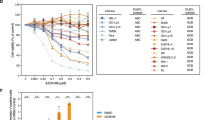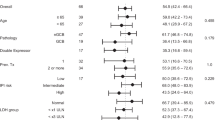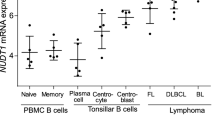Abstract
Current therapies for Burkitt's lymphoma (BL) utilise combined cytotoxic chemotherapy, but these treatments are not always available in areas where the disease is endemic and are also markedly less successful in AIDS-related BL. Therefore, additional therapies are urgently required. We demonstrate here that combined fibrates and MPA exert powerful, antiproliferative actions against well-characterised Daudi, Raji and L3055 BL cell lines and primary BL cells. Detailed studies in L3055 demonstrated that this activity was mediated by induced apoptosis and confirmed by observations that overexpression of the antiapoptotic genes bcl-2 or bcl-xL conferred significant protection against the drugs. Importantly, since fibrates and MPA are inexpensive and stable with minimal-associated toxicities, we suggest that these drugs should be considered as adjuncts to currently available treatments for BL in endemic and AIDS-related disease.
This is a preview of subscription content, access via your institution
Access options
Subscribe to this journal
Receive 12 print issues and online access
$259.00 per year
only $21.58 per issue
Buy this article
- Purchase on Springer Link
- Instant access to full article PDF
Prices may be subject to local taxes which are calculated during checkout




Similar content being viewed by others
References
Bouffet E, Frappaz D, Pinkerton R, Favrot M, Philip T . Burkitt's lymphoma: a model for clinical oncology. Eur J Cancer 1991; 27: 504–509.
Kearns DB, Smith RJH, Pitcock JK . Burkitt's lymphoma. Int J Pediatr Otorhinolaryngol 1986; 12: 73–84.
Ziegler JL . Treatment results of 54 American patients with Burkitt's lymphoma are similar to the African experience. N Engl J Med 1977; 297: 75–80.
Sandlund JT, Downing JR, Crist WM . Non-Hodgkin's lymphoma in children. N Engl J Med 1996; 334: 1238–1248.
Shapira J, Peylan-Ramu N . Burkitt's lymphoma. Oral Oncol 1998; 34: 15–23.
Bower M . Acquired immunodeficiency syndrome-related systemic non-Hodgkin's lymphoma. Br J Haematol 2001; 112: 863–873.
Straus DJ . Treatment of Hodgkin's disease: the role of radio- and/or chemotherapy in advanced stages. Baillieres Clin Haematol 1996; 9: 553–558.
Sucov HM, Evans RM . Retinoic acid and retinoic acid receptors in development. Mol Neurobiol 1995; 10: 169–184.
Faulkner L, Katz DR, Brickell PM . Retinoic acid induces changes in c-fgr proto-oncogene mRNA levels in Burkitt's lymphoma cells. Immunobiology 1993; 188: 460–468.
Quaia M, Zancai P, Cariati R, Rizzo S, Boiocchi M, Dolcetti R . Glucocorticoids promote the proliferation and antagonize the retinoic acid-mediated growth suppression of Epstein–Barr virus-immortalized B lymphocytes. Blood 2000; 96: 711–718.
Zancai P, Cariati R, Rizzo S, Boiocchi M, Dolcetti R . Retinoic acid-mediated growth arrest of EBV-immortalized B lymphocytes is associated with multiple changes in G1 regulatory proteins: p27Kip1 up-regulation is a relevant early event. Oncogene 1998; 17: 1827–1836.
Cariati R, Zancai P, Quaia M, Cutrona G, Giannini F, Rizzo S et al. Retinoic acid induces persistent, RARalpha-mediated anti-proliferative responses in Epstein–Barr virus-immortalized b lymphoblasts carrying an activated C-MYC oncogene but not in Burkitt's lymphoma cell lines. Int J Cancer 2000; 86: 375–384.
Fenton SL, Drayson MT, Hewison M, Vickers E, Brown G, Bunce CM . Clofibric acid: a potential therapeutic agent in AML and MDS. Br J Haematol 1999; 105: 448–451.
Bunce CM, Mountford JC, French PJ, Mole DJ, Durham J, Michell RH, et al. Potentiation of myeloid differentiation by anti-inflammatory agents, by steroids and by retinoic acid involves a single intracellular target, probably an enzyme of the aldoketoreductase family. Biochim Biophys Acta 1996; 1311: 189–198.
Wang H, Grand RJ, Milner AE, Armitage RJ, Gordon J, Gregory CD . Repression of apoptosis in human B-lymphoma cells by CD40-ligand and Bcl-2: relationship to the cell-cycle and role of the retinoblastoma protein. Oncogene 1996; 13: 373–379.
Gordon J, Challa A, Levens JM, Gregory CD, Williams JM, Armitage RJ et al. CD40 ligand, Bcl-2, and Bcl-xL spare group I Burkitt lymphoma cells from CD77-directed killing via Verotoxin-1 B chain but fail to protect against the holotoxin. Cell Death Differ 2000; 7: 785–794.
Serafeim A, Grafton G, Chamba A, Gregory CD, Blakely RD, Bowery NG et al. 5-Hydroxytryptamine drives apoptosis in biopsylike Burkitt lymphoma cells: reversal by selective serotonin reuptake inhibitors. Blood 2002; 99: 2545–2553.
Schuurhuis GJ, Oberink JW, Bontje PM, Broxterman HJ . The PGP specific combination Syto®16/PSC833 detects early apoptosis in CD34 positive progenitor cells. Exp Haematol 1997; 25: 754–759.
Izuo M, Yoshida M, Tominaga T, Abe O, Enomoto K, Nomura Y et al. A phase III trial of oral high-dose medroxyprogesterone acetate (MPA) versus mepitiostane in advanced postmenopausal breast cancer. Cancer 1985; 56: 2576–2579.
A co-operative trial in the primary prevention of ischaemic heart disease using clofibrate. Report from the Committee of Principal Investigators. Br Heart J 1978; 40: 1069–1118.
Bessell EM, Graus F, Lopez-Guillermo A, Villa S, Verger E, Petit J et al. CHOD/BVAM regimen plus radiotherapy in patients with primary CNS non-Hodgkin's lymphoma. Int J Radiat Oncol Biol Phys 2001; 50: 457–464.
Kobrinsky NL, Sposto R, Shah NR, Anderson JR, DeLaat C, Morse M et al. Outcomes of treatment of children and adolescents with recurrent non-Hodgkin's lymphoma and Hodgkin's disease with dexamethasone, etoposide, cisplatin, cytarabine, and L-asparaginase, maintenance chemotherapy, and transplantation: Children's Cancer Group Study CCG-5912. J Clin Oncol 2001; 19: 2390–2396.
Corn BW, Donahue BR, Rosenstock JG, Cooper JS, Xie Y, Brandon AH et al. Palliation of AIDS-related primary lymphoma of the brain: observations from a multi-institutional database. Int J Radiat Oncol Biol Phys 1997; 38: 601–605.
Kuppers R, Klein U, Hansmann ML, Rajewsky K . Cellular origin of human B-cell lymphomas. N Engl J Med 1999; 341: 1520–1529.
Liu YJ, Zhang J, Lane PJ, Chan EY, MacLennan IC . Sites of specific B cell activation in primary and secondary responses to T cell-dependent and T cell-independent antigens. Eur J Immunol 1991; 21: 2951–2962.
Hollowood K, Macartney J . Cell kinetics of the germinal center reaction – a stathmokinetic study. Eur J Immunol 1992; 22: 261–266.
Goodlad JR, Macartney JC . Germinal-center cell proliferation in response to T-independent antigens: a stathmokinetic, morphometric and immunohistochemical study in vivo. Eur J Immunol 1995; 25: 1918–1926.
Hollowood K, Goodlad JR . Germinal centre cell kinetics. J Pathol 1998; 185: 229–233.
Staels B, Dallongeville J, Auwerx J, Schoonjans K, Leitersdorf E, Fruchart JC . Mechanism of action of fibrates on lipid and lipoprotein metabolism. Circulation 1998; 98: 2088–2093.
Pineda Torra I, Gervois P, Staels B . Peroxisome proliferator-activated receptor alpha in metabolic disease, inflammation, atherosclerosis and aging. Curr Opin Lipidol 1999; 10: 151–159.
Scatena R, Nocca G, Sole PD, Rumi C, Puggioni P, Remiddi F et al. Bezafibrate as differentiating factor of human myeloid leukemia cells. Cell Death Differ 1999; 6: 781–6787.
Jones DC, Ding X, Daynes RA . Nuclear receptor peroxisome proliferator-activated receptor alpha (PPARalpha) is expressed in resting murine lymphocytes. The PPARalpha in T and B lymphocytes is both transactivation and transrepression competent. J Biol Chem 2002; 277: 6838–6845.
Desmond JC, Mountford JC, Drayson MT, Walker EA, Hewison M, Ride JP, et al. The Aldo-Keto Reductase AKR1C3 is a novel suppressor of cell differentiation that provides a plausible target for the non-cyclooxygenase-dependent antineoplastic actions of nonsteroidal anti-inflammatory drugs. Cancer Res 2003; 63: 505–512.
Padilla J, Kaur K, Cao HJ, Smith TJ, Phipps RP . Peroxisome proliferator activator receptor-gamma agonists and 15-deoxy-delta(12,14)(12,14)-PGJ(2) induce apoptosis in normal and malignant B-lineage cells. J Immunol 2000; 165: 6941–6948.
Padilla J, Kaur K, Harris SG, Phipps RP . PPAR-gamma-mediated regulation of normal and malignant B lineage cells. Ann NY Acad Sci 2000; 905: 97–109.
Padilla J, Kaur K, Phipps RP . Effects of 15-deoxy-delta 12,14-PGJ2 on B lineage cells. Ann NY Acad Sci 2000; 905: 322–325.
Matsuura K, Shiraishi H, Hara A, Sato K, Deyashiki Y, Ninomiya M et al. Identification of a principal mRNA species for human 3alpha-hydroxysteroid dehydrogenase isoform (AKR1C3) that exhibits high prostaglandin D2 11-ketoreductase activity. J Biochem 1998; 124: 940–946.
Kontula K, Paavonen T, Luukkainen T, Andersson LC . Binding of progestins to the glucocorticoid receptor. Correlation to their glucocorticoid like effects on in vitro functions of human mononuclear leukocytes. Biochem Pharmacol 1983; 32: 1511–1518.
Selman PJ, Wolfswinkel J, Mol JA . Binding specificity of medroxyprogesterone acetate and proligestone for the progesterone and glucocorticoid receptor in the dog. Steroids 1996; 61: 133–137.
Bamberger CM, Else T, Bamberger AM, Beil FU, Schulte HM . Dissociative glucocorticoid activity of medroxyprogesterone acetate in normal human lymphocytes. J Clin Endocrinol Metab 1999; 84: 4055–4061.
Tomeczkowski J, zur Stadt U, Reiter A, Welte K, Sykora KW . Absence of IL-6 receptor expression in fresh childhood Burkitt's lymphoma cells and induction of IL-6 receptors by Epstein–Barr virus in vitro. Br J Haematol 1997; 97: 400–408.
Mauray S, Fuzzati-Armentero MT, Trouillet P, Ruegg M, Nicoloso G, Hart M et al. Epstein–Barr virus-dependent lymphoproliferative disease: critical role of IL-6. Eur J Immunol 2000; 30: 2065–2073.
Drexler HG, Meyer C, Gaidano G, Carbone A . Constitutive cytokine production by primary effusion (body cavity-based) lymphoma-derived cell lines. Leukemia 1999; 13: 634–640.
Emilie D, Coumbaras J, Raphael M, Devergne O, Delecluse HJ, Gisselbrecht C et al. Interleukin-6 production in high-grade B lymphomas: correlation with the presence of malignant immunoblasts in acquired immunodeficiency syndrome and in human immunodeficiency virus-seronegative patients. Blood 1992; 80: 498–504.
Breen EC, van der Meijden M, Cumberland W, Kishimoto T, Detels R, Martinez-Maza O . The development of AIDS-associated Burkitt's/small noncleaved cell lymphoma is preceded by elevated serum levels of interleukin 6. Clin Immunol 1999; 92: 293–299.
Krauer KG, Belzer DK, Liaskou D, Buck M, Cross S, Honjo T et al. Regulation of interleukin-1beta transcription by Epstein–Barr virus involves a number of latent proteins via their interaction with RBP. Virology 1996; 252: 418–430.
Tatsuta T, Cheng J, Mountz JD . Intracellular IL-1beta is an inhibitor of Fas-mediated apoptosis. J Immunol 1996; 157: 3949–3957.
Acknowledgements
SLF and QTL contributed equally to this study. This work was funded by grants from the Leukaemia Research Fund (LRF), the Medical Research Council and the West Midlands Health Authority Locally Organized Research Scheme. CMB is the recipient of an LRF Bennett Senior Research Fellowship. JG is a Medical Research Council Professor whose work is supported by an MRC Programme Grant.
Author information
Authors and Affiliations
Rights and permissions
About this article
Cite this article
Fenton, S., Luong, Q., Sarafeim, A. et al. Fibrates and medroxyprogesterone acetate induce apoptosis of primary Burkitt's lymphoma cells and cell lines: potential for applying old drugs to a new disease. Leukemia 17, 568–575 (2003). https://doi.org/10.1038/sj.leu.2402843
Received:
Accepted:
Published:
Issue Date:
DOI: https://doi.org/10.1038/sj.leu.2402843
Keywords
This article is cited by
-
Probing the action of a novel anti-leukaemic drug therapy at the single cell level using modern vibrational spectroscopy techniques
Scientific Reports (2017)
-
Malonate as a ROS product is associated with pyruvate carboxylase activity in acute myeloid leukaemia cells
Cancer & Metabolism (2016)
-
Treatment of primary CLL cells with bezafibrate and medroxyprogesterone acetate induces apoptosis and represses the pro-proliferative signal of CD40-ligand, in part through increased 15dΔ12,14,PGJ2
Leukemia (2009)



